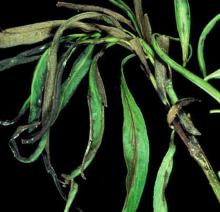See:
Cause Venturia chlorospora has been reported in Oregon and V. saliciperda in Washington. These fungi survive on old willow leaves on the ground and also on infected twigs. Spores spread during spring rains. Salix petandra, S. triandora, and S. viminalis are reported as fairly resistant; S. alba 'Calva' is immune.
Symptoms Shortly after new foliage develops in spring, brownish spots appear along leaf midribs; leaves scorch, wither, and drop. Defoliation is considerable, particularly toward limb terminals. Small brownish black cankers on twigs, which girdle limbs and twigs may also occur.
Cultural control
- In home landscapes, rake all fallen leaves and twigs and burn them before the spring growth period.
- Prune out diseased limbs and twigs if practical.
- Plant resistant types.
Chemical control In spring, spray two or three (3) times beginning when new leaves first appear and repeating at 14-day intervals, especially before wet weather.
- Armada 50 WDG at 3 to 9 oz/100 gal water. Do not use a silicone-based surfactant. Not for nursery or greenhouse use. Group 3 + 11 fungicide. 12-hr reentry.
- Eagle 20 EW at 6 to 12 fl oz/100 gal water. Pest not on label but is effective on other Venturia diseases. Group 3 fungicide. 24-hr reentry.
- Myclobutanil 20 EW T&O at 6 to 12 fl oz/100 gal water plus spreading agent. May observe a PGR effect. Group 3 fungicide. 24-hr reentry.
- Protect DF at 1 to 2 lb/100 gal water plus 2 to 4 oz spreader-sticker. Group M3 fungicides. 24-hr reentry.
- Spectracide Immunox Multi-Purpose Fungicide Spray Concentrate for Gardens at 1 fl oz/gal water. Group 3 fungicide. H
- Tebuject 16 is registered for tree injections. The number of capsules used is based on tree size. Group 3 fungicide.
Reference Sivanesan, A. 1976. Venturia saliciperda. CMI Descriptions of Pathogenic Fungi and Bacteria, No. 482. Surrey, England: Commonwealth Mycological Institute.



